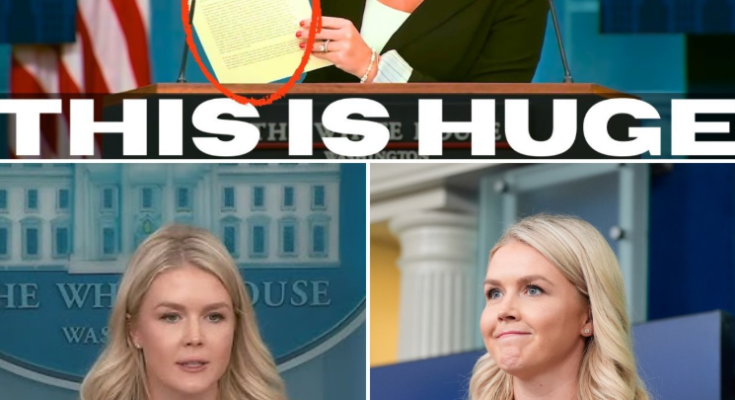In a dramatic turn at the White House press briefing this week, the administration unveiled a series of signed presidential letters destined for America’s most significant trading partners—a move that could reshape the global economic landscape and redefine the country’s approach to trade for years to come. The letters, addressed to leaders in South Korea, Japan, and soon a dozen more nations, mark the beginning of a sweeping, tailor-made tariff strategy intended to protect American workers and industries, while sending an unmistakable message: the era of “business as usual” in international trade is over.
The Announcement: A New Chapter in Trade
It was an ordinary press conference until, suddenly, the president’s spokesperson interrupted the routine exchange with reporters. “If you could get me the folder with the letters in them, Liz, they’re right in the previous office,” she called out. Moments later, she held aloft two official documents, each bearing the signature of the President of the United States—one addressed to the President of the Republic of Korea, another to the Prime Minister of Japan.
“These will be mailed,” she declared, her tone underscoring the gravity of the moment. “And there will be approximately 12 other countries that will receive notifications and letters directly from the president of the United States.”
The letters, she explained, outlined a new 25% tariff rate set to take effect on August 1st, a date pushed back from the originally scheduled July 9th deadline. The reason for the delay, she said, was simple: “The administration is doing what’s best for the American worker and we want the best deals possible for our workers, for our manufacturing base, for our middle class.”
Transparency and Tailor-Made Deals
The administration’s approach is as transparent as it is aggressive. Not only are these letters being sent directly to foreign leaders, but they will also be posted publicly on Truth Social, the president’s favored communications platform. The message is clear: the White House wants the American public—and the world—to know exactly where it stands, and how it intends to negotiate.
“We are creating tailor-made trade plans for each and every country on this planet,” the spokesperson emphasized, reiterating a promise made weeks earlier. “That’s what this administration continues to be focused on.”
The letters to South Korea and Japan are only the beginning. Over the coming days, a total of 55 countries—including the European Union as a bloc—will receive similar notifications. Each will be informed of the new tariff structure and the administration’s intent to renegotiate the terms of trade. For now, 12 countries are receiving their letters immediately, with the rest to follow soon after.
Why South Korea and Japan?
Reporters pressed the White House for details: Why start with South Korea and Japan? Was there any special reason? The spokesperson’s answer was blunt: “It’s the president’s prerogative, and those are the countries he chose.”
Yet, behind the scenes, analysts suggest the choice is strategic. Both South Korea and Japan are major U.S. trading partners with deep economic ties and complex trade histories. By starting with two of America’s closest allies in Asia, the administration signals its seriousness—and its willingness to challenge even its friends when it comes to protecting U.S. interests.
A Deliberate Delay
The decision to postpone the tariff implementation from July 9th to August 1st was also scrutinized. Was the administration struggling to negotiate deals? Had the “90 deals in 90 days” promise fallen short?
Not at all, said the spokesperson. The delay is a sign of deliberation, not difficulty: “This administration is doing what’s best for the American worker… They are doing this deliberately and appropriately on behalf of our country’s interests.”
She added that the president would sign an executive order formalizing the new timeline, giving all parties additional time to negotiate and potentially reach agreements before the tariffs take effect.
The Scope: A Global Reset
The scale of the administration’s trade overhaul is unprecedented. The spokesperson described the president as “literally looking at the map and looking at every country on the planet and seeing where they are ripping off the American people, seeing where they have hollowed out our industrial base, seeing where our jobs have gone to other countries overseas because of their tariff policies and he’s trying to correct that.”
This is not just a matter of tweaking a few trade agreements. It is a wholesale reevaluation of decades of U.S. trade policy—a direct response to what the administration views as a long history of American industries and workers being disadvantaged by unfair foreign practices and weak previous deals.
“These are decades of bad trade policy that have led to a deficit that is ravaging our country, that is ravaging our middle class,” she said. “The president is taking a very deliberate approach to correcting this wrong of many decades of many past presidents.”
Progress and Pushback
In just six months, the administration claims to have announced a new trade framework with China, reached a deal with the United Kingdom, and is close to finalizing agreements with Vietnam and other nations. Each negotiation, officials say, is guided by a singular focus: what’s best for the American worker.
But not everyone is convinced. Critics warn that aggressive tariffs could trigger retaliation, disrupt global supply chains, and ultimately raise prices for American consumers. Others worry that the administration’s go-it-alone strategy could isolate the U.S. from its allies at a time of rising geopolitical tensions.
Still, supporters argue that the bold approach is long overdue. “For too long, other countries have taken advantage of us,” said one manufacturing executive. “It’s about time someone stood up for American workers.”
The Road Ahead
As the letters make their way to capitals around the globe, the world is watching to see how America’s trading partners will respond. Will they negotiate new deals on Washington’s terms, or push back with tariffs of their own? Will the administration’s strategy succeed in rebuilding the nation’s industrial base, or will it spark a new era of trade wars?
What is certain is that the president’s actions have already changed the conversation. By making the process public, personal, and unapologetically focused on American interests, the administration has raised the stakes—and set a new standard for what a “deal” means in the 21st century.
As the spokesperson concluded, “He should be commended for the time and the effort that he is putting into this… It is truly historic and it’s a testament to this president and his trade team who are working around the clock to get this done.”
For better or worse, the world of global trade will never be the same. And it all started with a few signed letters, a bold vision, and a promise to put America first.

